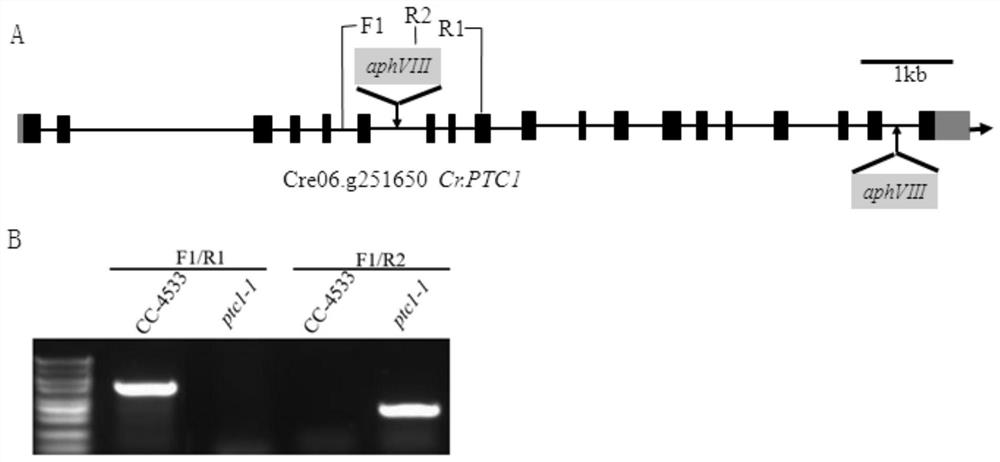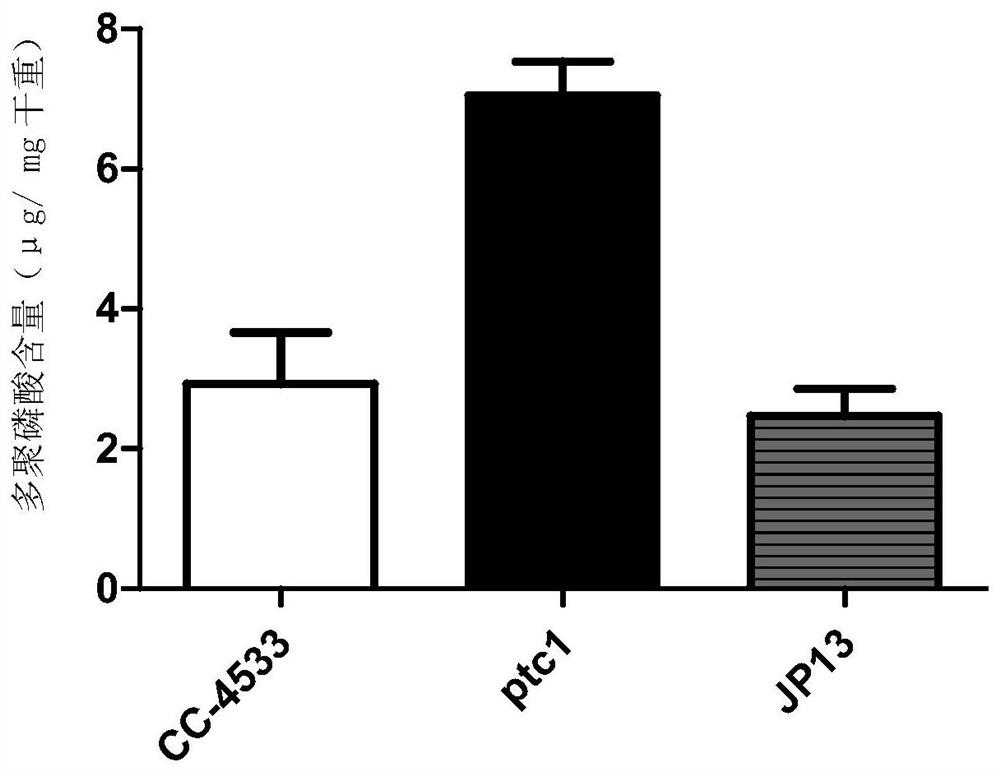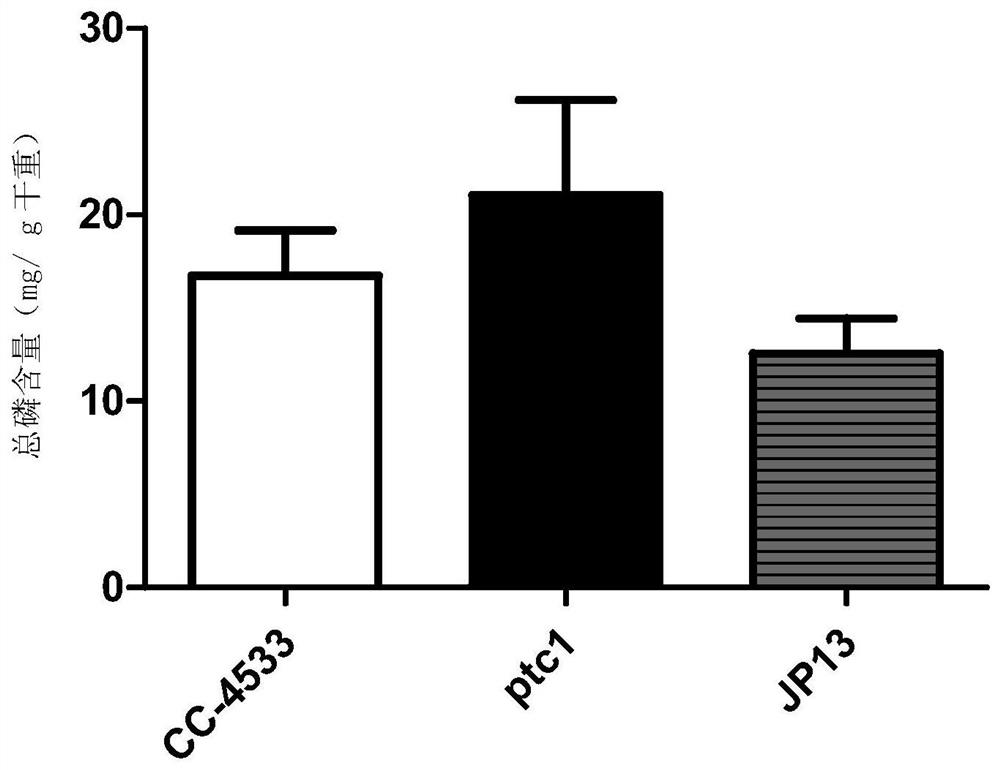A method and application of increasing algae total phosphorus and polyphosphoric acid content through ptc gene manipulation
A polyphosphoric acid and phosphorus content technology, applied in the direction of microorganism-based methods, chemical instruments and methods, biochemical equipment and methods, etc., can solve the problems of low cost and high technical requirements
- Summary
- Abstract
- Description
- Claims
- Application Information
AI Technical Summary
Problems solved by technology
Method used
Image
Examples
Embodiment 1
[0048] Embodiment 1, the preparation of recombinant Chlamydomonas
[0049] Both Chlamydomonas CC-4533 and Chlamydomonas mutants were purchased from https: / / www.chlamylibrary.org / . The Chlamydomonas mutant is Mutant strain: LMJ.RY0402.181899 in https: / / www.chlamylibrary.org / , and it is named Chlamydomonas mutant ptc1.
[0050] Extract the genomic DNA of Chlamydomonas chinensis, and use F1 / R1 primer pair or F1 / R2 primer pair to carry out PCR amplification (primer design principles of F1, R1 and R2 see figure 1 Primer F1: GGGCCGTACACCTAACTTGA; Primer R1: ACCTCTACATTGGCCAGCAC; Primer R2: GACGTTACAGCACACCCTTG; the target sequence of F1 and R1 is about 1410bp, and the target sequence of F1 and R2 is about 800bp), the electropherogram of the PCR amplification product is shown in figure 1 b. The tested Chlamydomonas were: Chlamydomonas CC-4533 and Chlamydomonas mutant ptc1.
[0051] Whole genome sequencing of Chlamydomonas was performed. The tested Chlamydomonas were: Chlamydomo...
Embodiment 2
[0053] The detection of polyphosphoric acid content in embodiment 2, Chlamydomonas
[0054] The tested Chlamydomonas were Chlamydomonas CC-4533, Chlamydomonas mutant ptc1 and Chlamydomonas JP13.
[0055] 1. Prepare the solution
[0056] Ammonium molybdate solution: containing 28mM ammonium molybdate and 2.1M H 2 SO 4 , and the balance is water.
[0057] Malachite green solution: containing 0.76mM malachite green and 0.35g / 100ml polyvinyl alcohol, and the balance is water.
[0058] Neutral red mother liquor: contains 0.1g / 100ml neutral red, and the balance is water.
[0059] Neutral red solution: 60 μl neutral red mother solution and 940 μl Tris-HCl buffer solution (pH7.5, 1M), mix well.
[0060] NaI solution: containing 6M NaI, the balance is water, adjust the pH to 7.0.
[0061] Wash buffer: containing 50% (volume ratio) ethanol, 1mM EDTA, 100mM NaCl, and the balance is Tris-HCl buffer solution (pH7.5, 10mM).
[0062] 2. Make a standard curve
[0063] use KH 2 PO 4 ...
Embodiment 3
[0088] The detection of total phosphorus content in embodiment 3, Chlamydomonas
[0089] The tested Chlamydomonas were Chlamydomonas CC-4533, Chlamydomonas mutant ptc1 and Chlamydomonas JP13.
[0090] Cultivate Chlamydomonas. Cultivation method: Inoculate Chlamydomonas to TAP medium, 24°C, 12h light (light intensity 150μmol m -2 the s -1 ) / 12h dark, 150rpm shaking culture, until the concentration of Chlamydomonas in the culture system for the test is 5×10 7 cells / ml.
[0091] Take two equal volumes of the culture system that have completed the above steps, one is dried to constant weight (weighed, that is, dry weight), and the other is tested for total phosphorus content.
[0092] For the method of detecting total phosphorus content, see the reference: Bajhaiya AK, Dean AP, Zeef LA, Webster RE, Pittman JK (2016) PSR1Is a Global Transcriptional Regulator of PhosphorusDeficiency Responses and Carbon Storage Metabolism in Chlamydomonasreinhardtii. Plant Physiol 170:1216-12
...
PUM
 Login to View More
Login to View More Abstract
Description
Claims
Application Information
 Login to View More
Login to View More - R&D
- Intellectual Property
- Life Sciences
- Materials
- Tech Scout
- Unparalleled Data Quality
- Higher Quality Content
- 60% Fewer Hallucinations
Browse by: Latest US Patents, China's latest patents, Technical Efficacy Thesaurus, Application Domain, Technology Topic, Popular Technical Reports.
© 2025 PatSnap. All rights reserved.Legal|Privacy policy|Modern Slavery Act Transparency Statement|Sitemap|About US| Contact US: help@patsnap.com



